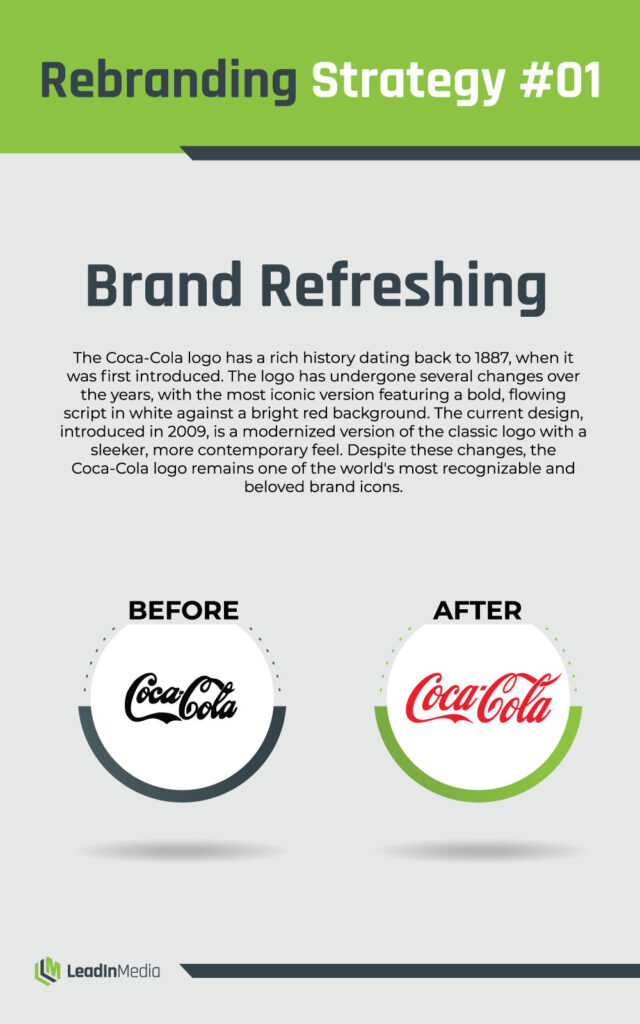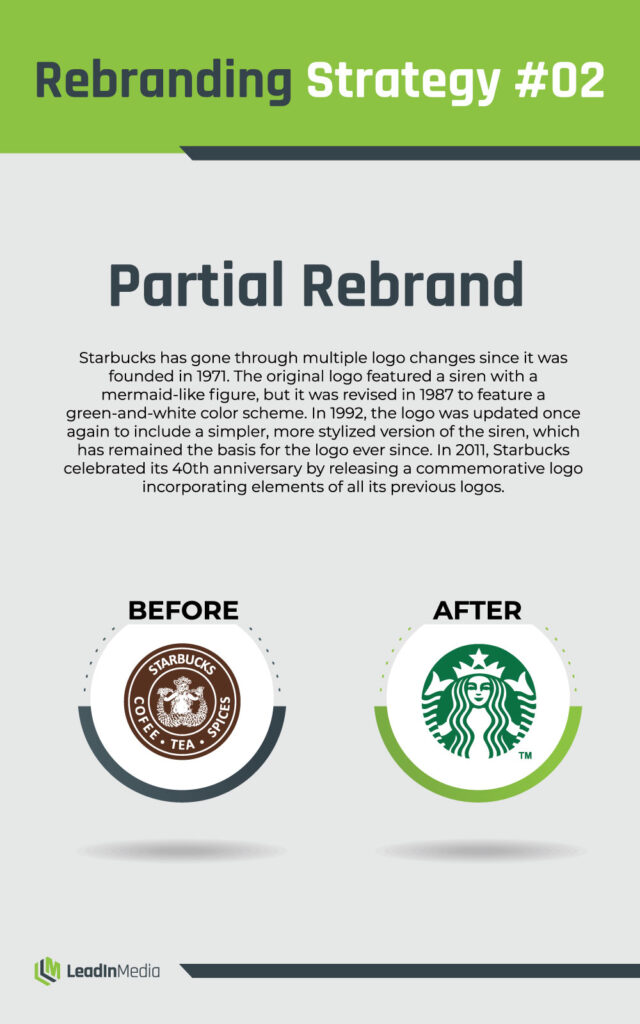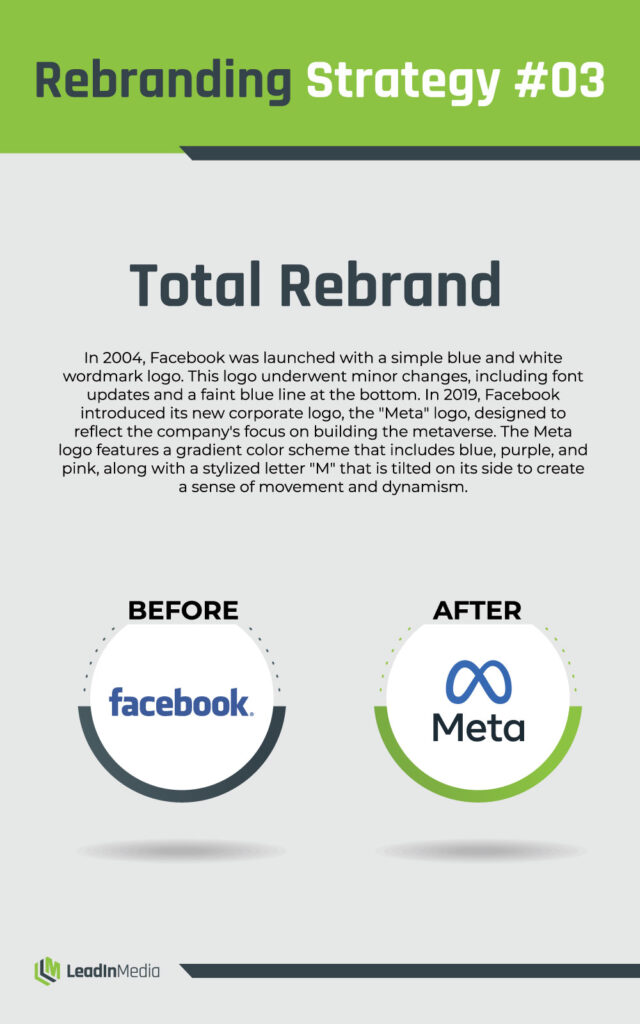Are you contemplating giving your company a makeover by rebranding? In our constantly evolving world, revamping and rejuvenating your brand’s appearance and identity can be the ultimate key to staying ahead of the competition in your industry.
Embracing the new and out with the old! Rebranding encompasses more than just designing a new logo and overhauling your website.
If your mission statement is no longer relevant, your brand values have evolved, and you’re facing a sales slump, it’s time to brainstorm and strategize your rebranding goals with your target audience in mind.
It’s important to consider the changes you wish to make and areas for improvement.
In this article, we’ll explore the significance of rebranding, factors to consider, steps to follow, and common mistakes to avoid.
What is Rebranding?
Rebranding is when a company decides to spruce up its branding elements, such as its logo, color palette, typography, and other aspects of its marketing strategy. The goal is to create a fresh new identity in the minds of their customers and other stakeholders.
Now, before you go ahead and decide to rebrand your business, it’s essential to understand why you’re doing it.
Rebranding can involve changing everything from your slogan to your company name, or you can opt for minor changes like modernizing your logo or tweaking the hues of your color palette.
It’s helpful to think of rebranding in three categories:
Brand Refresh
When it comes to brand identity, small changes can make a big impact. For example, you might freshen up your logo by giving it a more modern look or tweak the colors in your palette ever so slightly. These subtle changes can greatly impact how your audience perceives your brand.

Partial Rebrand
You may choose to keep some elements while changing others. For example, you might opt for a new logo incorporating elements, themes, and colors from your previous logo. This approach allows you to refresh your brand while maintaining its identity and familiarity.

Total Rebrand
A total rebrand is a major overhaul that transforms your company into something entirely new. Think of it as hitting the reset button and starting fresh with a new identity, from your logo and messaging to your products and services. It’s like becoming a whole new entity in the eyes of your customers and the market.

The level of change you choose depends on your goals and what you want to accomplish.
While it may not always be necessary, a successful rebrand can help take your business to the next level if you’re willing to take the risk.
Pros & Cons of Rebranding
On the positive side, rebranding can help you attract new customers and rekindle interest from your existing audience. In addition, if your image and message have become stagnant or irrelevant, a rebrand can make you more relevant, competitive, and profitable in your target market.
It also allows you to shift your focus and achieve new goals, such as developing new products or improving existing ones. Plus, a rebrand can increase engagement by allowing you to make a big splash and get people talking about your company.
However, there are some downsides to consider. Rebranding involves change, which can be scary for employees and customers. Confusion can bring chaos, so it’s important to communicate clearly and often throughout the process.
You may also risk losing some existing customers, even if you do everything right. And be prepared to spend some money – a complete rebrand is definitely an investment.
Is it Time to Rebrand Your Company?
Before jumping into a rebranding project, consider a few things:
- Why do you feel the need to rebrand?
- What changes are you thinking of?
- Were there any recent changes within your company that could affect your rebranding efforts?
It’s essential to weigh the potential benefits and risks of rebranding carefully. Suppose you’re considering a brand refresh because of sluggish sales or poor brand recognition.
While a successful rebrand can be highly beneficial, the process can be complex and risky.
Even large companies like Uber have struggled with rebranding, with nearly half of the people needing clarification about their new logo.
In that case, it might be worth exploring alternative solutions like creating a new marketing strategy or conducting market research to identify the root cause of the problem.
Remember, rebranding should be a strategic decision for the right reasons, not just a quick fix for temporary setbacks.
How to Rebrand Your Business?
Making a successful rebrand can be challenging, but you can follow a few key steps to help streamline the process and increase your chances of success.
These steps will help ensure that you successfully reestablish your brand’s audience and market and redefine your company’s vision, mission, and values.
Take a Close Look at Your Audience & Market
Conduct market research and analyze data to understand who is buying from you and your competitors. This may reveal differences between your initial target market and audience. Once you know your actual market and audience, you can start rebranding to connect with them.
Redefine Your Vision, Mission, and Values
Ask yourself what you are doing, how you are doing it, and why you are doing it. Your vision acts as the North Star for every action your company undertakes, and your mission is your company’s roadmap. Your values act as the why behind your brand.
Consider Your Brand Voice
As you redefine your vision, mission, and values, how you convey these aspects of your company will also need to change. The vocabulary, tone, and voice you use for your brand have to match your message.
Evaluate Your Slogan and Identity
When considering a rebrand, carefully evaluating your brand’s slogan and identity is important. Before changing your slogan, consider why you want to make the change and whether your current slogan resonates with your customers.
If you decide to change it, you can make a claim using metaphorical language, providing instructions, leveraging labels, complimenting customers, or using poetic language.
Revisit Your Imagery and Shapes
Rebranding can also involve redesigning your logo, choosing new colors, and revisiting your typography and imagery.
When redesigning your logo, it’s important to keep it simple, impactful, adaptable, and appropriate for your target market. You should also consider the long-term implications of your new logo and aim to maintain throughlines with your old logo.
When choosing your new color palette, consider color psychology and competitor research, and ensure the color looks consistent across all brand materials.
Fun fact: Did you know that incorporating colors into your brand can increase recognition by up to 80%? By using a consistent color scheme across all of your marketing materials and products, you can help your brand stand out in the minds of consumers.
When revisiting your typography, consider what worked and what didn’t with your old font and whether it’s consistent with any new markets or messages uncovered during rebranding.
Finally, when revisiting your imagery and shapes, ensure they’re cohesive with your new branding elements.
Prepare for Launch
Rebranding is more than just changing your website’s colors, fonts, or logo. It involves communicating your new message: your updated mission, values, and vision. To do this effectively, planning a successful rebranding launch is crucial.
First, consider posting ads online or in print, TV, radio, or other mediums. Next, announce your rebranding launch with a press release on your website and a social media post explaining why your company needed a rebrand and what it means for the future.
A successful rebranding can ensure consistency and on-brand messaging in all your future marketing efforts. This is important because it’s easy for businesses to lose focus over time. So, take the time to plan your rebranding launch carefully and set your business up for success.
What are the Mistakes to Avoid During Rebranding?
Let’s explore some common mistakes that businesses make during rebranding and how to avoid them:
Forgetting to Keep Your Brand Equity
Rebranding can be exciting and rejuvenating for your business, but retaining your current brand equity is crucial. Radical changes can scare away loyal customers, hurting your business in the long run. Take the time to understand what your customers love about your brand and ensure your rebranding efforts stay true to those elements.
Not Understanding the Purpose of Rebranding
Before embarking on a rebranding project, ask yourself why you’re doing it. Is it necessary for business growth or just a shot in the dark? Identify the specific areas of your branding that need improvement and those that work well to set clear goals and maintain brand equity.
Skipping Consultation
It’s tempting to handle rebranding on your own, but this can be a mistake. Business owners may be too close to their brand to see it objectively or lack the skills to conduct effective market research. A consultant can provide valuable feedback and guidance from an unbiased perspective.
Lack of Consistency Across Channels
Ensure that your rebranding efforts are consistent across all channels. Customers should have a uniform experience whether they interact with your brand in-store, on your website, or through advertising. Inconsistent branding can confuse and frustrate customers.
Losing Sight of Objectives
When rebranding, it’s essential to keep your objectives in focus. What do you hope to achieve? What aspects of your brand need improvement? Without clear goals, measuring success and evaluating your efforts is difficult.
5 Rebranding Success Stories
Rebranding is a powerful tool for businesses to revamp their image, and some brands have managed to do it exceptionally well.
Exploring the history of well-known brands can offer valuable insights into how rebranding can effectively reposition a product, service, or business.
Here are five examples of rebranding strategies that worked:
- Old Spice: The deodorant brand partnered with NFL player Isaiah Mustafa to create a series of commercials that showed Old Spice as a fresh and relevant brand. The commercials were a hit, and the brand improved its awareness by creating brand consistency.
- Dunkin: In 2019, Dunkin’ Donuts decided to rebrand itself by introducing a new logo that eliminated the word “Donuts” from its name. The objective of the new name is to streamline and modernize its name while still paying tribute to its roots. Despite the name change, Dunkin’ retained its recognizable pink and organic hues and iconic font to preserve its identity and maintain its loyal customer base.
- Burberry: Luxury brand Burberry rebranded to create a new image without abandoning its roots, keeping its authenticity while modernizing its look.
- Dropbox: In 2017, Dropbox refreshed its logo to reflect its new products, APIs, tools, and integrations. The new logo is cleaner and more straightforward, reflecting the evolution of Dropbox from a file-sharing service to a full suite that connects teams and businesses of all sizes.
- McDonald’s: McDonald’s rebranded its logo and brand messaging in 2020. The new logo is more simplified and modern, and the brand messaging focuses on the company’s values of community, quality, and sustainability.
These brands successfully rebranded by staying authentic, keeping their audience in mind, and not being afraid to make bold moves.
Are You Ready to Rebrand Your Company?
Now that you’ve gained a good grasp of what rebranding entails, it’s time to consider whether rebranding your business is the right move and how to execute it successfully.
At LeadIn Media, we take a personalized and transparent approach to rebranding. We aim to understand your brand story, target market, and desired outcomes and collaborate with you to develop a digital-first design and data-driven messaging that sets your brand apart in a constantly evolving marketplace.
If you’re looking to outshine your competition and effectively connect with your target audience, get in touch with us. We’ll collaborate with you to develop a personalized plan that aligns with your vision, mission, and values.




